2011 Peugeot 3008 Hybrid 4 ignition
[x] Cancel search: ignitionPage 148 of 280
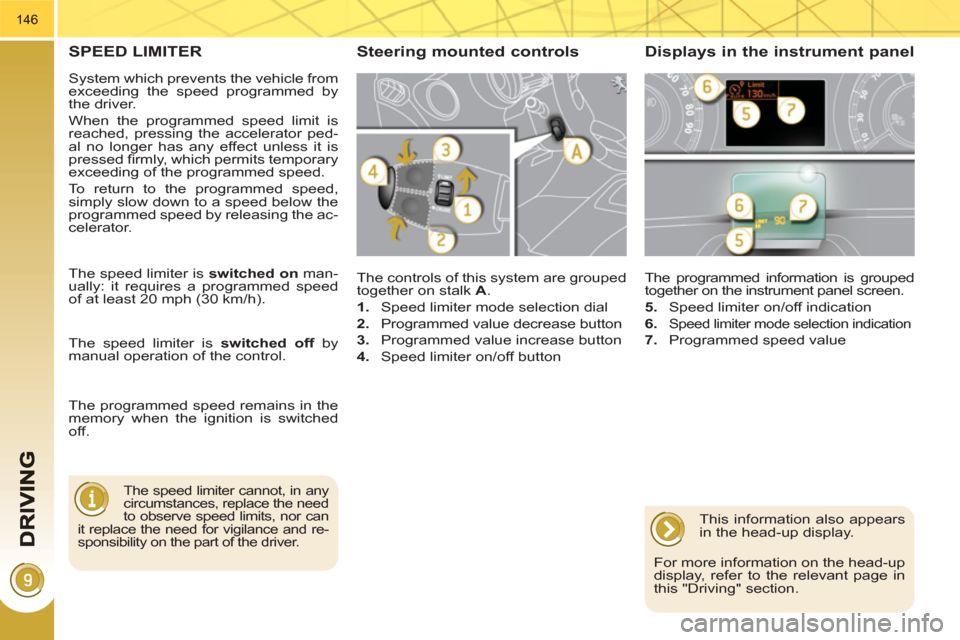
146
SPEED LIMITER
The controls of this system are grouped
together on stalk A
.
1.
Speed limiter mode selection dial
2.
Programmed value decrease button
3.
Programmed value increase button
4.
Speed limiter on/off button
The programmed information is grouped
together on the instrument panel screen.
5.
Speed limiter on/off indication
6.
Speed limiter mode selection indication
7.
Programmed speed value
Steering mounted controls Displays in the instrument panel
The speed limiter cannot, in any
circumstances, replace the need
to observe speed limits, nor can
it replace the need for vigilance and re-
sponsibility on the part of the driver.
The speed limiter is switched on
man-
ually: it requires a programmed speed
of at least 20 mph (30 km/h).
The speed limiter is switched off
by
manual operation of the control.
The programmed speed remains in the
memory when the ignition is switched
off.
This information also appears
in the head-up display.
For more information on the head-up
display, refer to the relevant page in
this "Driving" section.
System which prevents the vehicle from
exceeding the speed programmed by
the driver.
When the programmed speed limit is
reached, pressing the accelerator ped-
al no longer has any effect unless it is
pressed fi rmly, which permits temporary
exceeding of the programmed speed.
To return to the programmed speed,
simply slow down to a speed below the
programmed speed by releasing the ac-
celerator.
Page 150 of 280
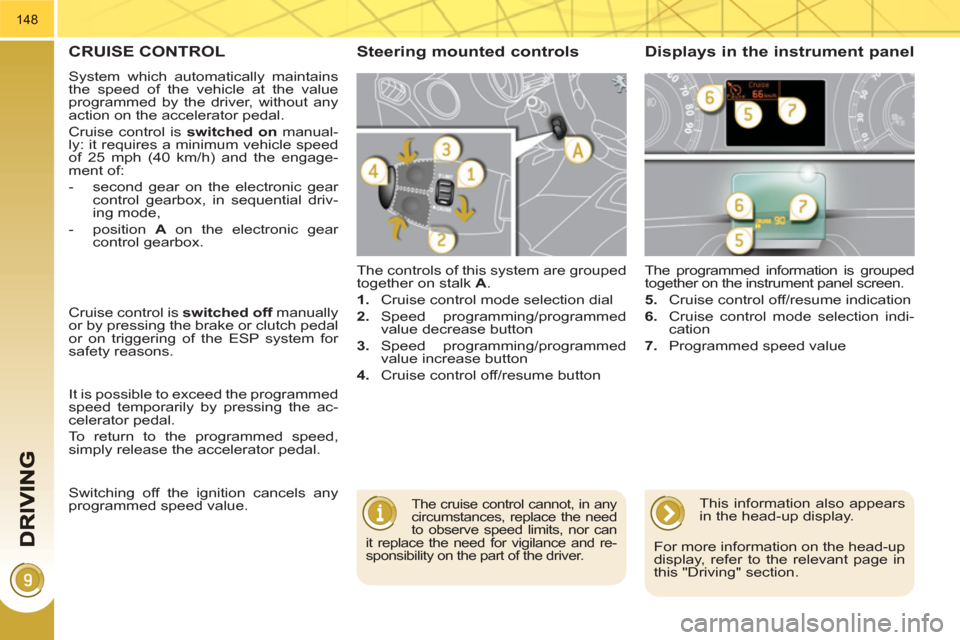
148
CRUISE CONTROL
System which automatically maintains
the speed of the vehicle at the value
programmed by the driver, without any
action on the accelerator pedal.
Cruise control is switched on
manual-
ly: it requires a minimum vehicle speed
of 25 mph (40 km/h) and the engage-
ment of:
- second gear on the electronic gear
control gearbox, in sequential driv-
ing mode,
- position A
on the electronic gear
control gearbox.
The controls of this system are grouped
together on stalk A
.
1.
Cruise control mode selection dial
2.
Speed programming/programmed
value decrease button
3.
Speed programming/programmed
value increase button
4.
Cruise control off/resume button The programmed information is grouped
together on the instrument panel screen.
5.
Cruise control off/resume indication
6.
Cruise control mode selection indi-
cation
7.
Programmed speed value
Steering mounted controls Displays in the instrument panel
The cruise control cannot, in any
circumstances, replace the need
to observe speed limits, nor can
it replace the need for vigilance and re-
sponsibility on the part of the driver.
Cruise control is switched off
manually
or by pressing the brake or clutch pedal
or on triggering of the ESP system for
safety reasons.
It is possible to exceed the programmed
speed temporarily by pressing the ac-
celerator pedal.
To return to the programmed speed,
simply release the accelerator pedal.
Switching off the ignition cancels any
programmed speed value.
This information also appears
in the head-up display.
For more information on the head-up
display, refer to the relevant page in
this "Driving" section.
Page 155 of 280
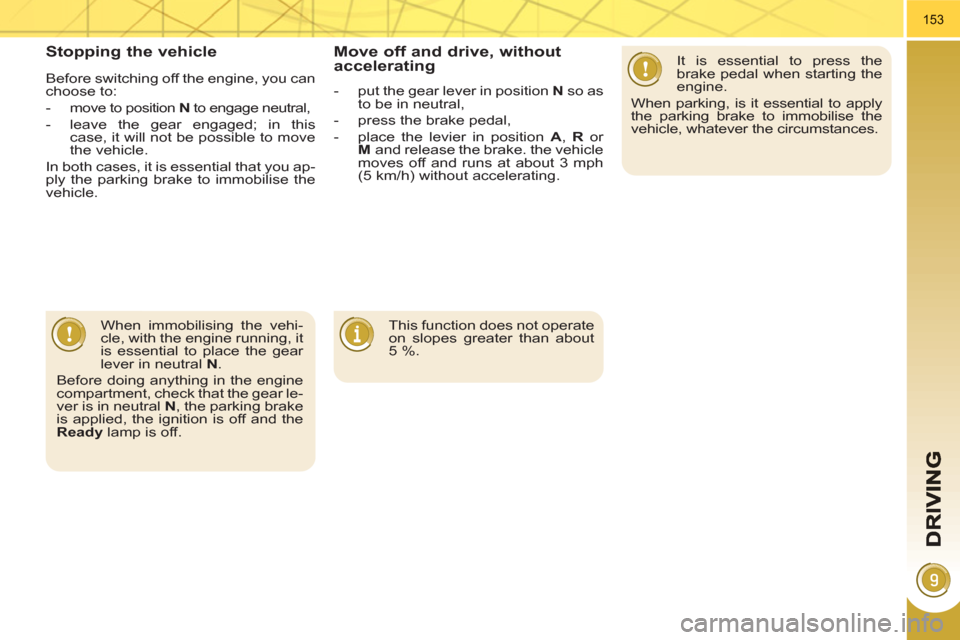
153
Stopping the vehicle
It is essential to press the
brake pedal when starting the
engine.
When parking, is it essential to apply
the parking brake to immobilise the
vehicle, whatever the circumstances.
When immobilising the vehi-
cle, with the engine running, it
is essential to place the gear
lever in neutral N
.
Before doing anything in the engine
compartment, check that the gear le-
ver is in neutral N
, the parking brake
is applied, the ignition is off and the
Ready
lamp is off.
Before switching off the engine, you can
choose to:
- move to position N
to engage neutral,
- leave the gear engaged; in this
case, it will not be possible to move
the vehicle.
In both cases, it is essential that you ap-
ply the parking brake to immobilise the
vehicle.
Move off and drive, without accelerating
- put the gear lever in position N
so as
to be in neutral,
- press the brake pedal,
- place the levier in position A
, R
or
M
and release the brake. the vehicle
moves off and runs at about 3 mph
(5 km/h) without accelerating.
This function does not operate
on slopes greater than about
5 %.
Page 162 of 280

CHECKS
160
CHECKING LEVELS
Brake fluid level
On vehicles which are fi tted with a par-
ticle emission fi lter, the fan may oper-
ate after the vehicle has been switched
off, even if the engine is cold.
In addition, as the cooling system is
pressurised, wait at least one hour after
switching off the engine before carrying
out any work.
To avoid any risk of scalding, unscrew
the cap by two turns to allow the pres-
sure to drop. When the pressure has
dropped, remove the cap and top up
the level.
Oil level
The reading will only be correct
if the vehicle is on level ground
and the engine has been off for
more than 15 minutes.
The check is carried out either when the
ignition is switched on using the oil level
indicator on the instrument panel, or us-
ing the dipstick. The brake fl uid level should be
close to the "MAX" mark. If it is
not, check the brake pad wear.
Changing the fl uid
Refer to the Warranty and Maintenance
Record for details of the interval for this
operation.
Power steering fluid level
The power steering fl uid level
should be close to the "MAX"
mark. Unscrew the cap, with the
engine cold, to check the level.
Screenwash and headlamp
wash fluid
In the case of vehicles fi tted
with headlamp washers, the
minimum level of this fl uid is
indicated by an audible signal
and a message on the multi-
function screen.
Top up the level when you stop the ve-
hicle.
Engine oil change
Refer to the Warranty and Maintenance
Record for details of the interval for this
operation.
In order to maintain the reliability of the
engine and emission control system,
the use of additives in the engine oil is
prohibited.
Oil specifi cation
The oil must correspond to your engine
and conform to the manufacturer's rec-
ommendations.
Fluid specifi cation
The brake fl uid must conform to the
manufacturer's recommendations and
fulfi l the DOT4 standards.
Changing the coolant
The coolant does not have to be
changed.
Fluid specifi cation
For optimum cleaning and to avoid
freezing, this fl uid must not be topped
up with or replaced with plain water.
Coolant level
The coolant level should be
close to the "MAX" mark but
should never exceed it.
When the engine is warm, the tempera-
ture of the coolant is regulated by the
fan. This can operate with the ignition off.
Fluid specifi cation
The coolant must conform to the manu-
facturer's recommendations.
When working under the bon-
net, take care, as certain areas
of the engine may be extreme-
ly hot (risk of burns).
Before doing anything under
the bonnet, switch off the igni-
tion ( Ready
lamp off) to avoid
any risk of injury resulting from auto-
matic operation of the motor.
Check all of these levels regularly and
top them up if necessary, unless other-
wise indicated.
If a level drops signifi cantly, have the
corresponding system checked by a
PEUGEOT dealer.
Page 167 of 280
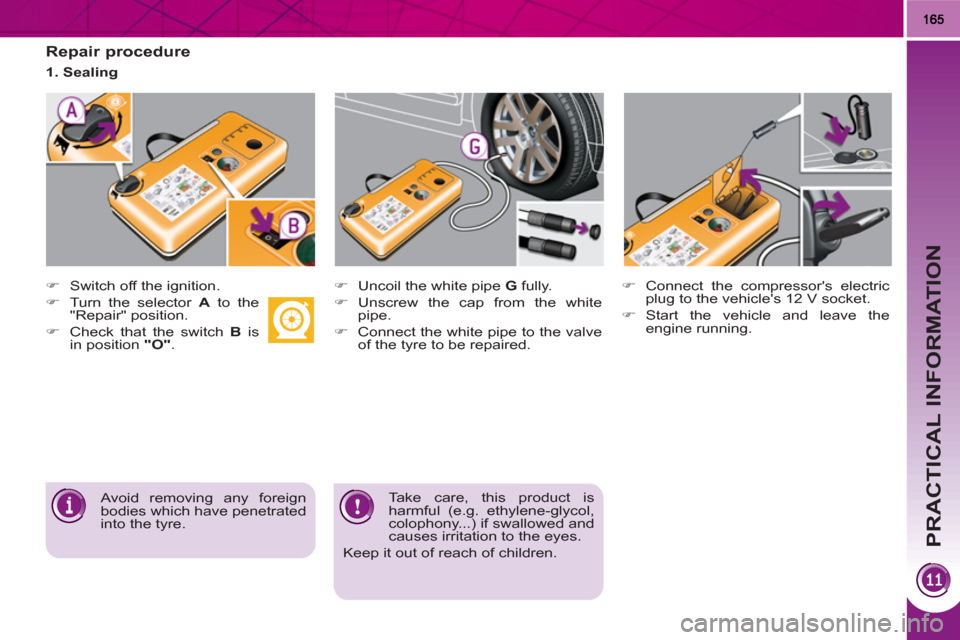
PRACTICAL INFORMATION
Repair procedure
�)
Switch off the ignition.
�)
Turn the selector A
to the
"Repair" position.
�)
Check that the switch B
is
in position "O"
.
Avoid removing any foreign
bodies which have penetrated
into the tyre.
Take care, this product is
harmful (e.g. ethylene-glycol,
colophony...) if swallowed and
causes irritation to the eyes.
Keep it out of reach of children.
1. Sealing
�)
Uncoil the white pipe G
fully.
�)
Unscrew the cap from the white
pipe.
�)
Connect the white pipe to the valve
of the tyre to be repaired.
�)
Connect the compressor's electric
plug to the vehicle's 12 V socket.
�)
Start the vehicle and leave the
engine running.
Page 171 of 280

PRACTICAL INFORMATION
169
CHANGING A WHEEL
The tools are stowed in the boot.
Access to the tools
Procedure for changing a faulty wheel
for the spare wheel using the tools pro-
vided with the vehicle.
All of these tools are specifi c to your
vehicle. Do not use them for other
purposes.
1.
Wheelbrace *
.
For removing the wheel trim and
removing the wheel fi xing bolts.
2.
Jack with integral handle *
.
For raising the vehicle.
3.
"Bolt cover" tool (according to
equipment) *
.
For removing the bolt protectors
(covers) on alloy wheels.
4.
Centring guide *
.
For refi tting an alloy wheel to the
hub.
List of tools
Other accessories
5.
Socket for the security bolts
(located in the glove box) *
.
For adapting the wheelbrace to
the special "security" bolts.
6.
Two chocks to immobilise the
vehicle.
7.
Removable towing eye.
Refer to "Electric parking brake"
in the "Driving" section.
Refer to the paragraph "Towing
the vehicle".
8.
Electric parking brake emergency
release control.
Before doing any work on your
vehicle, switch off the ignition
( Ready
lamp off) to avoid any
risk of injury resulting from automatic
operation of the engine.
*
According to country.
Take care to use the jacking
points provided for the jack to
avoid damaging the cables.
Page 172 of 280
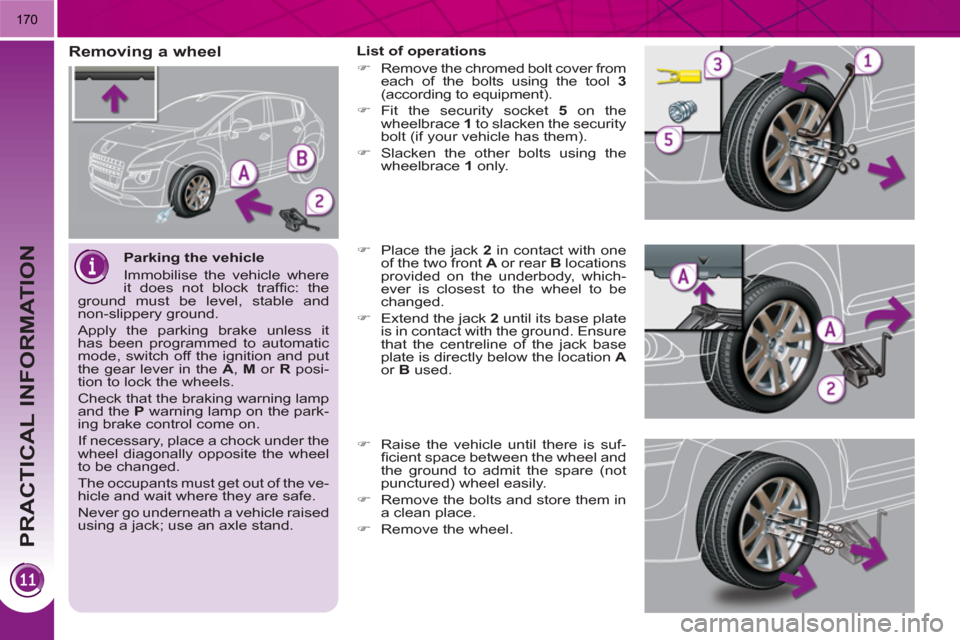
PRACTICAL INFORMATION
170
Parking the vehicle
Immobilise the vehicle where
it does not block traffi c: the
ground must be level, stable and
non-slippery ground.
Apply the parking brake unless it
has been programmed to automatic
mode, switch off the ignition and put
the gear lever in the A
, M
or R
posi-
tion to lock the wheels.
Check that the braking warning lamp
and the P
warning lamp on the park-
ing brake control come on.
If necessary, place a chock under the
wheel diagonally opposite the wheel
to be changed.
The occupants must get out of the ve-
hicle and wait where they are safe.
Never go underneath a vehicle raised
using a jack; use an axle stand.
Removing a wheel
List of operations
�)
Remove the chromed bolt cover from
each of the bolts using the tool 3
(according to equipment).
�)
Fit the security socket 5
on the
wheelbrace 1
to slacken the security
bolt (if your vehicle has them).
�)
Slacken the other bolts using the
wheelbrace 1
only.
�)
Place the jack 2
in contact with one
of the two front A
or rear B
locations
provided on the underbody, which-
ever is closest to the wheel to be
changed.
�)
Extend the jack 2
until its base plate
is in contact with the ground. Ensure
that the centreline of the jack base
plate is directly below the location A
or B
used.
�)
Raise the vehicle until there is suf-
fi cient space between the wheel and
the ground to admit the spare (not
punctured) wheel easily.
�)
Remove the bolts and store them in
a clean place.
�)
Remove the wheel.
Page 174 of 280
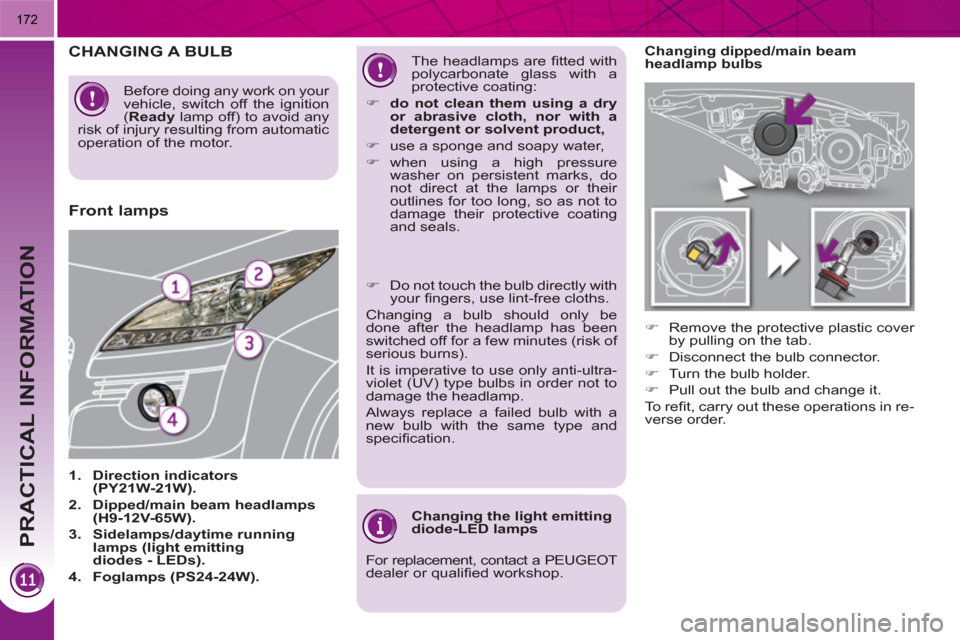
PRACTICAL INFORMATION
172
Changing dipped/main beam
headlamp bulbs
�)
Remove the protective plastic cover
by pulling on the tab.
�)
Disconnect the bulb connector.
�)
Turn the bulb holder.
�)
Pull out the bulb and change it.
To r efi t, carry out these operations in re-
verse order.
CHANGING A BULB
1.
Direction indicators
(PY21W-21W).
2.
Dipped/main beam headlamps
(H9-12V-65W).
3.
Sidelamps/daytime running
lamps (light emitting
diodes - LEDs).
4.
Foglamps (PS24-24W).
The headlamps are fi tted with
polycarbonate glass with a
protective coating:
�)
do not clean them using a dry
or abrasive cloth, nor with a
detergent or solvent product,
�)
use a sponge and soapy water,
�)
when using a high pressure
washer on persistent marks, do
not direct at the lamps or their
outlines for too long, so as not to
damage their protective coating
and seals.
Front lamps
�)
Do not touch the bulb directly with
your fi ngers, use lint-free cloths.
Changing a bulb should only be
done after the headlamp has been
switched off for a few minutes (risk of
serious burns).
It is imperative to use only anti-ultra-
violet (UV) type bulbs in order not to
damage the headlamp.
Always replace a failed bulb with a
new bulb with the same type and
specifi cation.
Changing the light emitting
diode-LED lamps
For replacement, contact a PEUGEOT
dealer or qualifi ed workshop.
Before doing any work on your
vehicle, switch off the ignition
( Ready
lamp off) to avoid any
risk of injury resulting from automatic
operation of the motor.